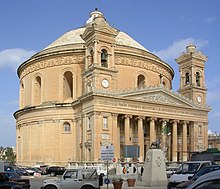Rotunda of Mosta
| Rotunda of the Assumption Knisja Arċipretali tal-Assunta Template:Mt icon | |
|---|---|
 Facade of the Rotunda of the Assumption. | |
| Religion | |
| Affiliation | Roman Catholic |
| Ecclesiastical or organizational status | Parish |
| Year consecrated | 1871 |
| Location | |
| Location | Mosta, Malta |
| Geographic coordinates | 35°54′36.29″N 14°25′33.24″E / 35.9100806°N 14.4259000°E |
| Architecture | |
| Architect(s) | Giorgio Grognet de Vassé |
| Type | Church |
| Groundbreaking | 1614 |
| Completed | 1860s |
| Specifications | |
| Direction of façade | SSE |
| Length | 75 metres (246 ft) |
| Width | 55 metres (180 ft) |
The Church of the Assumption of Our Lady, commonly known as the Rotunda of Mosta or Rotunda of St Marija Assunta (sometimes shortened to as The Mosta Dome) is a Roman Catholic church in Mosta, Malta. It is the third largest unsupported dome in the world and the third largest in Europe.[1][2]
History
Built in the 19th century on the site of a previous church, it was designed by the Maltese architect Giorgio Grognet de Vassé. Its dome is among the largest in the world, with an internal diameter of 37.2 metres (122 ft);[3][4] the rotunda walls are 9.1 metres (30 ft) thick (necessary to support the weight of the dome).[3] The rotunda dome is the third-largest church dome in Europe and the ninth largest in the world.
Grongnet's plans were based on the Pantheon in Rome. Construction began in May 1833 and was completed in the 1860s. The original church was left in place while the Rotunda was built around it, allowing the local people to have a place of worship while the new church was being built. The church was officially consecrated on the 15 of October 1871.[5]
Mosta bomb miracle
On April 9, 1942, during an afternoon air-raid, a SC500 kg general purpose Luftwaffe bomb pierced the dome (one 50 kg bomb bounced off) and fell among a congregation of more than 300 people awaiting early evening mass. It did not explode. The same type of bomb as pierced the dome is now on display ( the original was dumped at sea) at the back of the church in the Sacristy under the words Il-Miraklu tal-Bomba, 9 ta' April 1942 (Maltese: The Bomb Miracle, April 9, 1942).
Gallery
-
Interior of the Rotunda of St Marija Assunta
-
View of the dome from inside the church.
-
Replica of the bomb which pierced the dome. Nowadays the area where the bomb hit is still visible.
See also
- Culture of Malta
- History of Malta
- List of Churches in Malta
- List of largest domes in the world
- Religion in Malta
Notes
- ^ Malta - The Mythical Island - Travelling Wizards 2010, ISBN 1460921011
- ^ In the Image of His God: The Curse of the Shroud - Outskirts Press Inc. Denver, Colorado, 2008, ISBN 9781432728786
- ^ a b Macdonald 2002, p. 156
- ^ Cauchi 1988, p. 79
- ^ http://maltadiocese.org/lang/en/parishes/mosta/
References
- Macdonald, William (2002). The Pantheon:design, meaning, and progeny. New York: Knopf Books for Young Readers. ISBN 978-0-674-01019-2.
- Cauchi, Raymond (1988). The Mosta Rotunda: short history & guide. Cauchi's Emporium.


